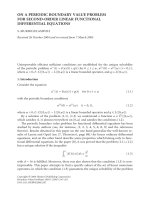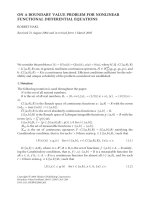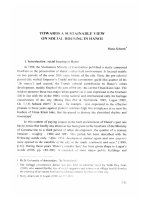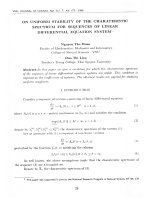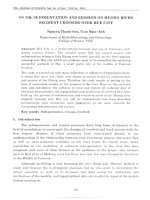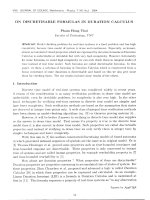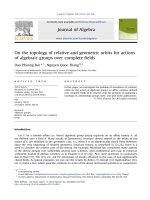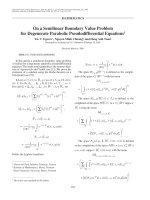DSpace at VNU: On a semilinear boundary value problem for degenerate parabolic pseudodifferential equations
Bạn đang xem bản rút gọn của tài liệu. Xem và tải ngay bản đầy đủ của tài liệu tại đây (247.02 KB, 5 trang )
ISSN 1064–5624, Doklady Mathematics, 2009, Vol. 80, No. 1, pp. 482–486. © Pleiades Publishing, Ltd., 2009.
Published in Russian in Doklady Akademii Nauk, 2009, Vol. 427, No. 2, pp. 155–159.
MATHEMATICS
On a Semilinear Boundary Value Problem
for Degenerate Parabolic Pseudodifferential Equations1
Yu. V. Egorova, Nguyen Minh Chuongb, and Dang Anh Tuanc
Presented by Academician V.S. Vladimirov February 18, 2009
Received March 6, 2009
DOI: 10.1134/S1064562409040085
In this article a semilinear boundary value problem
is studied for a degenerate parabolic pseudodifferential
equation. The main result generalizes the famous theorem of Agranovich and Vishik (see [1]). We prove the
existence of a solution using the Rothe theorem on a
fixed point (see [2]).
+∞
1
ᏸ u ( x, t ) = --------------1/2
( 2π )
The space H(l, p, δ)(ޒ
⎛
( ξ', q ) δ, d = ⎜
ξi
⎝i = 1
∑
p/ ( 1 + δ i )
xn
pδ i
+ q
p/d⎞
tion of the space
∞
C0 (
u ( x, t ) dt.
0
⎛
= ⎜
⎝
,
) is defined as the comple-
ޒ
n – 1)
v
1/ p
⎟
⎠
– qt
n–1
1. Let p ∈ (1, ∞), l ∈ ޒ+, q = µ + iτ ∈ ރ, µ ≥ 0, d ≥ 1,
d ∈ ޚ, δ = (δ1, δ2, …, δn – 1, 0), δi ≥ 0, i = 1, 2, …, n – 1.
For each ξ' = (ξ1, ξ2, …, ξn – 1) ∈ ޒn – 1, xn ∈ ޒ+, set
n–1
∫e
l, p, d, δ, ޒ
n–1
⎞
( 1 + ( ξ', q ) δ, d ) Ᏺ n – 1 v ( ξ', q ) dξ'⎟
⎠
n–1
∫
ޒ
with the norm
⎛
p
( ξ', x n, q ) δ, d = ⎜
ξi xn
⎝i = 1
∑
pδ i
+ q
p/d⎞
n
∞
completion of the space P( ޒ+ ) = {u ∈ C 0 (ޒn): suppu ∈
1/ p
⎟
⎠
ޒ+ } using the norm
n
,
u
⎛
= ⎜
⎝j = 0
∫
ޒ
e
– i 〈 x', ξ'〉
∑ ∫ ∫ ( 1 + ( ξ', q )
u ( x', x n, q ) d x',
n
l, p, d, δ, ޒ+
+∞
l
Ᏺ n – 1 u ( ξ', x n, q )
1
= ------------------------( n – 1 )/2
( 2π )
.
The space H(l, p, δ)( ޒ+ ) (l ∈ ޚ+) is defined as the
n
n–1
1/ p
p
lp
ޒ
n–1
δ, d
+ ( ξ', x n, q ) δ, d )
(l – j) p
0
1
---
n–1
∫
Ᏺ n – 1 v ( ξ', q )
⎞p
p
j
× D n Ᏺ n – 1 u ( ξ', x n, q ) d x n dξ' ⎟ .
⎠
The space Pl, p(d, µ, δ, ޒ+ × (0, +∞)) is defined
n
1
= ------------------------( n – 1 )/2
( 2π )
∫
ޒ
e
– i 〈 x', ξ'〉
v ( x', q ) d x'.
n–1
∞
as the completion of the space P(ޒn) = {u ∈ C 0 (ޒn ×
(–∞, +∞)): suppu ⊂ ޒ+ × (0, +∞)} with the norm
n
Define the Laplace transform
u
n
P l, p ( d, µ, δ, ޒ+ × ( 0, +∞ ) )
+∞
⎛ l
p(l – j)
⎜
=
( 1 + ( ξ', q ) δ, d + ( ξ', x n, q ) δ, d )
⎜
⎝ j = 0 ޒnξ', τ 0
∑∫ ∫
a
Université Paul Sabatier, Toulouse, France
Institute of Mathematics, Hanoi, Vietnam
c Hanoi National University, Hanoi, Vietnam
b
1
---
1 The
∫
article was translated by the authors.
482
⎞p
p
j
– µt
× D n Ᏺ n u ( e u ( x, t ) ) ( ξ', x n, τ ) d x n dξ' dτ ⎟ .
⎠
ON A SEMILINEAR BOUNDARY VALUE PROBLEM
∂Ω, are defined in the standard way using a unity partition.
2. Consider a pseudodifferential operator L(x, D, q, y)
with a symbol
The space Pl, p(d, µ, δ, ޒn – 1 × (0, +∞)) is defined as
∞
C0 (
{v ∈
× ޒ
the completion of the space P∞(ޒ
n
–
1
× (0, +∞)} with the norm
(–∞, +∞)): suppv ⊂ ޒ
n – 1) =
v
P l, p ( d, µ, δ, ޒ
n–1
n–1
∑
L ( x, ξ, q, d ) =
× ( 0, +∞ ) )
∫
where m ∈ ޚ+, γi = 1 + δi, i = 1, 2, …, n, lα ≥ 0,
(0)
is defined as the comThe space El, p(d, µ, δ, ޒ
pletion of the space ᏸP(ޒn – 1) with the norm
E l, p ( d, µ, δ, ޒ
n–1
)
(0)
aα ( · ) ∈ C ( ޒ
ޒτ
(1)
E l, p ( d, µ, δ, ޒ
⎛
= ⎜
⎝
v
p
l, p, q, d, δ, ޒ
ޒτ
n
+
∑
n
(1)
b j ( ·,
ξ' ) ∈
∞
C0 (
(1)
(1)
b j ( x', · ) ∈ C ( ޒ
n–1
∫
γn – 1
∀ξ' ∈ ޒ
α' β
α
b j ( x', λ 1 ξ 1, λ 2 ξ 2, …, λ
γn – 1
e
– i 〈 x', ξ'〉
∀λ > 0,
(1)
ξ n – 1 ) = a α ( x, ξ' ),
n–1
\ { 0 }, ∀λ > 0.
l
a α( x, ξ')x nα (ξ' ) q D n n Ᏺ n – 1 u(ξ', x n, q) dξ'.
γ
γ
∀λ > 0, ∀ξ' ∈ ޒ
n–1
\ { 0 } ),
n–1
ξn – 1 ) = λ
k – dj ( 1 )
b j ( x,
\ { 0 }, ∀ x' ∈ ޒ
) ޒ, ∀ξ' ∈ ޒ
γn – 1
n–1
ξ' ),
.
n–1
∫
ޒ
e
i 〈 x', ξ'〉
n–1
× b ( x', ξ', q, d ) Ᏺ n – 1 v ( ξ', q )dξ'.
n–1
ξn – 1 ) =
∀λ > 0, ∀ξ' ∈ ޒ
DOKLADY MATHEMATICS
1
b ( x', D', q, d )v ( x', q ) = ------------------------( n – 1 )/2
( 2π )
, ∀ j,
n
λ ξ 2, …, λ
(0)
ξ n – 1 ) = a α ( ξ' ),
A pseudodifferential operator b(x', D', q, d) with a
symbol b(x', ξ', q, d) is denned as usually:
\ { 0 }, ∀ j,
(1)
γ2
\ { 0 },
Let us introduce the operator
j
supp b j (·, ξ') ⊂ Kj, Kj are compact sets independent
of ξ',
γ
(0)
b j ( λ 1 ξ 1,
γn – 1
\ { 0 },
γ
∀x ∈ ޒ,
+ b j ( x', ξ' ) )q ,
where
∀ x' ∈ ޒ
n–1
n–1
α + dβ ≤ 2m
ޒ
〈 γ , α〉 + dβ – l α = 2m
j=0
\ { 0 } ),
γ
(1)
n–1
a α ( x, λ 1 ξ 1, λ 2 ξ 2, …, λ
k
n–1
γ
∀ξ' ∈ ޒ
(1)
(0)
j ( ξ' )
γ
(0)
dτ⎟ .
⎠
Let us now set
(0)
∀ξ' ∈ ޒ
n
a α ( λ 1 ξ 1, λ 2 ξ 2, …, λ
1
--⎞p
1
L ( x, D, q, d )u ( x, q ) = ------------------------( n – 1 )/2
( 2π )
b j ∈ C(ޒ
\ { 0 } ),
(1)
∫
∑ (b
n–1
supp a α (·, ξ') ⊂ Kα, where Kα are compact sets independent of ξ'
The spaces Pl, p(d, µ, δ, ∂Ω × (0, +∞)), Pl, p(d, µ, δ,
Ω × (0, +∞)), El, p(d, µ, δ, ∂Ω) and El, p(d, µ, δ, Ω),
where Ω is a bounded set in ޒn with smooth boundary
b ( x', ξ', q, d ) =
∞
a α ( ·, ξ' ) ∈ C 0 ( ) ޒ,
The space El, p(d, µ, δ, ޒis defined as the completion of the space ᏸP∞(ޒn) with the norm
n
+)
(1)
\ { 0 } ), a α ( x, · ) ∈ C ( ޒ
∀ x, ∀α ,
n
+)
v
n–1
1
---
⎞p
p
v l, p, q, d, δ, ޒn – 1 dτ⎟ .
⎠
∫
(1)
a α ( x, ξ' ) = a α ( ξ' ) + a α ( x, ξ' ),
n – 1)
v
α β
l
a α ( x, ξ' )x nα ξ n q ,
α + dβ ≤ 2m
〈 γ , α〉 + dβ – l α = 2m
1
⎛
⎞ --pp
pl
–
µt
= ⎜ 1 + ( ξ', q) δ, d ) Ᏺn [ e v ( x', t) ](ξ', τ) dξ' dτ⎟ .
⎜
⎟
⎝ ޒnξ', τ
⎠
⎛
= ⎜
⎝
483
L ( x n, D, q, d )U ( x, q ) = F ( x, q ),
B j ( D, q, d )U ( x, q )
k – dj ( 0 )
λ
b j ( ξ' ),
\ { 0 },
Vol. 80
3. Consider the problem
2009
= G j ( x', q ),
j = 1, 2, …, m,
where
No. 1
x=0
x ∈ ޒ+ ,
n
(1)
(2)
484
EGOROV et al.
∑
L ( x n, D, q, d ) =
l
xn, q), 1 ≤ k ≤ m, 0 ≤ j ≤ 2m, are continuous in (ξ', xn, q).
Moreover,
α β
a α ( ξ' )x nα ξ q ,
α + dβ ≤ 2m
〈 γ , α〉 + dβ – l α = 2m
aα ∈ C ( ޒ
n–1
γ1
2m
γ2
\ { 0 } ), a α ( λ ξ 1, λ ξ 2, …, λ
= a α ( ξ' ), ∀λ > 0, ∀ξ' ∈ ޒ
∑
B j ( ξ', q, d ) =
n–1
γn – 1
γ
γ
= E l – 2m, p (d, µ, δ, ޒ
×
∏E
j=0
µ, δ, ޒ
n–1
).
to El, p(d, µ, δ, ޒ
n
+,
ޒ
α>0
n – 1)
l, p (d,
µ, δ, α, ޒ+ , ޒn – 1)
n
such that
(i) for any α > 0: R0 is bounded from El, p(d, µ, δ, α)
to El, p(d, µ, δ);
(ii) for any α > 0, (F, G) ∈ El, p(d, µ, δ, α), Ꮽ0R0(F,
G) = (F, G) + Q(F, G), where Q is bounded from El, p(d,
µ, δ, α) to
E l, p (d, µ, δ, α);
∩
l>0
(iii) U ∈ El, p(d, µ, δ, ޒ+ and U(x', xn) = 0 for xn ≥ α
with some α > 0, then R0Ꮽ0U = U.
Proof. Remark that (F, G) ∈ El, p(d, µ, δ, α) for almost
all q ∈ C, Req = µ, (F, G) ∈ H(l, p, δ) and F(x', xn) = 0 for
xn ≥ α.
It is evident that there exists a unique function v(ξ', xn),
such that L(xn, ξ', Dn, q, d)v(ξ', xn) = Ᏺn – 1F(ξ', xn, q),
v(ξ', xn) = 0, for sufficiently large xn.
n
bounded from the space El, p(d, µ, δ, ޒ+ ) to the space
n
El, p(d, µ, δ, ޒ+ , ޒn – 1).
n
The operator Ꮽ(xn, D, q, d) and problem (1), (2) are
elliptic, if
l
a α (ξ') x nα ξαqβ ≠ 0,
α + dβ ≤ 2m
〈 δ, α〉 + dβ – l α = 2m
0
∀ξ ∈ ޒn, q ∈ ރ, |ξ| + |q| ≠ 0, ∀xn > 0;
(ii) the equation L0(xn, ξ', ξn, q, d) = 0 has m solutions ξn with positive imaginary parts for xn > 0, |ξ'| +
|q| ≠ 0;
(iii) the Cauchy problem
L ( x n, ξ', D n, q, d )v ( x n, q ) = 0, x n > 0;
0
B j ( ξ', D n, q, d )v ( 0, q ) = h j ,
∪E
bounded operator R0 from
)
1 ( d,
l – m j – --p
∑
1 ≤ k ≤ m.
n
Proposition 1. The operator Ꮽ(xn, D, q, d) is
(i) L0(xn, ξ, q, d) =
≠0
ޒ+ , ޒn – 1)|F(x', xn) = 0 for xn > α}, then there exists a
m
n
+)
0 ≤ j ≤ m – 1,
xn = 0
n
\ { 0 }.
n–1
≤ C ( ( ξ', q ) δ, d ).
El, p(d, µ, δ, α, ޒ+ , ޒn – 1) = {(F, G) ∈ El, p(d, µ, δ, α,
For l ≥ l0, we set
n
p
Lp
Theorem 1. Let Ꮽ be an ellipic operator. If
Set l0 = max{2m, mj + 1}, Ꮽ(xn, D, q, d)u = (L(xn, D, q,
d)u, Bj(D, q, d) u xn = 0 ).
E l, p ( d, µ, δ, ޒ+, ޒ
j
for ξ' + q ≠ 0,
ξ n – 1 ) = b jkm ( ξ' ),
n–1
D n Φ k ( ξ', x n, q )
detB j ( ξ', D n, q, d )Φ k ( ξ', x n, q )
\ { 0 } ),
∀ξ' ∈ ޒ
∀λ > 0,
c xn
Suppose that
k l
γn – 1
e
j = 0k = 1
\ { 0 },
b jkl ( ξ' )ξ n q ,
n–1
b jkm ( λ 1 ξ 1, λ 2 ξ 2, …, λ
∑∑
ξn – 1 )
k + dl = m j
b jkl ∈ C ( ޒ
m
j = 1, 2, …, m
has a unique solution, tending to 0 as xn → +∞ for any
hj ∈ ޒ.
Proposition 2. Suppose that L0(xn, ξ, q, d) ≠ 0, ∀q ∈
ރ, |ξ| + |q| ≠ 0, ∀xn > 0, and the equation L0(x, ξ', ξn,
q, d) = 0 has m solutions ξn with positive Imξn for |ξ'| +
|q| ≠ 0, xn > 0. Then the space Nξ', q of solutions to the
equation L(xn, ξ', Dn, q, d)v(xn, q) = 0 has dimension m,
with the base Φ1(ξ', xn, q), …, Φm(ξ', xn, q) and D n Φk(ξ',
j
0
Denote G ξ', q the map: (F, G) ۋv. Then G ξ', q is a
linear bounded map from Lp(0, α) to H2m, p(ޒ+) continuous in (ξ', q). Set
R 0 ( F, G ) = Ᏺ n – 1 [ θG ξ', q ( Ᏺ n – 1 F ( ξ', x n, q ) )
–1
0
+ ( 1 – θ) Ꮽ ξ', q ( Ᏺ n – 1 F ( ξ', x n, q ) Ᏺ n – 1 G ( ξ', q ) ) ],
–1
⎧ 1 if ( ξ', q ) δ, d < 1
θ = θ ( ( ξ', q ) δ, d ) = ⎨
⎩ 0 if ( ξ', q ) δ, d ≥ 2.
4. Consider the problem
∂
L ⎛ x n, D, -----, d⎞ u ( x, t ) = f ( x, t ),
⎝
∂t ⎠
∂
B j ⎛ D, -----, d⎞ u ( x, t )
⎝ ∂t ⎠
xn = 0
x ∈ ޒ+ ,
n
= g 0 ( x', t ),
t > 0,
t > 0,
j = 1, 2, …, m.
DOKLADY MATHEMATICS
Vol. 80
No. 1
2009
ON A SEMILINEAR BOUNDARY VALUE PROBLEM
Theorem 2. Suppose that the operator Ꮽ(xn, D, q, d)
∞
C0 (
ޒthere exists an ε > 0,
is elliptic. Then for any ψ ∈
such that for 0 < ε ≤ ε0, there exists a linear operator R
with the following properties:
(i) for any a ≥ 0: R is bounded from the space
n
P l, p (d, µ, δ, a, ޒ+ × (0, +∞), ޒn – 1 × (0, +∞)) to
n)
∪
The operator Ꮽ(x, D, q, d) = (L(x, D, q, d), Bj(x, D, q,
d)|∂Ω is elliptic at a point y ∈ Ω, if for y ∉ ∂Ω there is a
neighborhood U ∩ ∂Ω = , y ∈ U, in which ϕiLψi has
the principal part
Pl, p(d, µ, δ, ( × ޒ0, +∞));
(ii) for any a > 0, ( f, g) ∈ Pl, p(d, µ, δ, a, ( × ޒ0, +∞),
( × ޒ0, +∞))
n
+
0
α + dβ = 2m
–γ 1
x 1, …, ε
–γ n
L i ( x, ξ, q )
0
∑
=
l
α + dβ = 2m
〈 γ , α〉 + dβ – l α = 2m
for x ∈ U i \∂Ω,
B ij ( x', ξ, q, d ) =
0
n
(0, +∞)) →
∩P
µ, δ, ޒ
n–1
l, p (d,
× (0, +∞)); is bounded;
∑
b jkl ( x', ξ' )ξ n q .
k l
Then the trivial solution of the Cauchy problem
L i ( 0, x n, ξ', D n, q, d )v ( x n ) = 0,
0
(iii) if u ∈ Pl, p(d, µ, δ, ( × ޒ0, +∞)) and u(x', xn, t) = 0,
for xn ≥ a, then
n
+
∂
∂
R ⎛ Ꮽ 0 ⎛ x n, D, -----, d⎞ + ψ ε ( x ) ⎛ Ꮽ ⎛ x, D, -----, d⎞
⎝ ⎝
⎝ ⎝
∂t ⎠
∂t ⎠
∂
– Ꮽ 0 ⎛ x n, D, -----, d⎞ ⎞ ⎞ u = u.
⎝
∂t ⎠ ⎠ ⎠
5. Let Ω be a bounded set in ޒn with smooth boundary ∂Ω. Consider the problem
∂
L ⎛ x, D, -----, d⎞ u ( x, t ) = f ( x, t ),
⎝
∂t ⎠
x ∈ Ω,
∂
B j ⎛ x, D, -----, d⎞ u ( x, t ) = g j ( x, t ),
⎝
∂t ⎠
t > 0,
where
ξ + q ≠ 0,
k + dl = m j
l=0
N
{Ui, ϕi } i = 1
α β
ϕ i ( x )a iα ( x, ξ' )x nα ξ q ≠ 0
and ϕiBjψi has the principal part
x n ),
the operator T: Pl, p(d, µ, δ, ޒ+ × (0, +∞), ޒn – 1 ×
∞
ξ + q ≠ 0;
for y ∈ ∂Ω there is a neighborhood Ui ∩ ∂Ω ≠ , y ∈ Ui,
in which ϕiLψi has the principal part
∂
– Ꮽ 0 ⎛ x n, D, -----, d⎞ ⎞ ⎞ R ( f , g ) = ( f , g ) + T ( f , g ),
⎝
∂t ⎠ ⎠ ⎠
where ψ ε ( x ) = ψ ( ε
β
ϕ ( x )a iα ( x, ξ )q ≠ 0
for x ∈ U i ,
n–1
∂ ⎞
∂
⎛ Ꮽ ⎛ x , D, ----, d + ψ ε ⎛ Ꮽ ⎛ x, D, -----, d⎞
⎝ 0⎝ n
⎝ ⎝
∂t ⎠
∂t ⎠
∑
L i ( x, ζ, q, d ) =
a>0
n
+
485
t > 0, (3)
x ∈ ∂Ω,
(4)
B ij ( 0, ξ', D n, q, d )v ( 0 ) = 0,
0
j = 1, 2, …, m, for ξ' + q ≠ 0
is the only its bounded solution.
Theorem 3. Let the operator Ꮽ(x, D, q, d) be
elliptic.
Then for all sufficiently large µ = Req and for any
( f, g) ∈ Pl + 1, p(d, µ, δ, Ω × (0, +∞), ∂Ω × (0, +∞)), problem (3), (4) has a unique solution u ∈ Pl, p(d, µ, δ,
Ω × (0, +∞)).
6. Consider the problem
∂
L ⎛ x, D, -----, d⎞ u ( x, t )
⎝
∂t ⎠
= f ( x , t , u ( x , t ), …, D x
2m – 1
j = 1, 2, …, m,
∂
B j ⎛ x, D, -----, d⎞ u ( x, t )
⎝
∂t ⎠
= 1 is a partition of unity in Ω and
∞
the functions ψi ∈ C 0 (Ω) are such that suppψi ⊂ Ui and
ψi(x) = 1 in a neighborhood of suppϕi.
After the Laplace transform problem (3), (4) goes to
the problem:
L ( x, D, q, d ) ᏸ u ( x, q ) = ᏸ f ( x, q ),
x ∈ Ω,
B j ( x, D, q, d ) ᏸ u ( x, q ) = ᏸ g j ( x, q ),
x ∈ ∂Ω,
Vol. 80
No. 1
m –1
= g j ( x', t, u ( x, t ), …, D x j
∂Ω
u ( x, t ) ), t > 0,
(6)
j = 1, 2, …, m;
∂ u ( x, t )
-------------------k
∂t
k
= 0,
l
k = 0, 1, …, ---0 ,
d
(7)
t=0
where f, qj satisfy the following conditions:
(i) the maps (x, t, u) ۋf (x, t, u) and (x, t, uj) ۋgj(x,
t, uj) satisfy the Caratheodory conditions, i.e. they are
j = 1, 2, …, m.
DOKLADY MATHEMATICS
u ( u, t ) ), x ∈ Ω, t > 0; (5)
2009
486
EGOROV et al.
continuous in u = (u1, u2, …, uN), uj = (u1, u2, …, u N j )
for almost all x, and measurable in x, t for all u, uj,
(ii) the maps u(x, t) ( ۋf (x, t, u(x, t)), gj(x, t,
j
u (x, t))), where
u ( x, t ) = ( u ( x, t ), …, D x
2m – 1
j
(iii) there exists a r > 0, such that
∂
–1
1 ≥ lim sup Ꮽ ⎛ x, D, -----, d⎞ × ( f , g j )
⎝
⎠
∂t
µ → +∞
u ( x, t );
m –1
u ( x , t ) = ( u ( x , t ), … , D x j
from Pl, p(d, µ, δ, Ω × (0, +∞)) to Pl, p(d, µ, δ, Ω × (0,
+∞), ∂Ω × (0, +∞)) are compact;
u ( x, t ) )
where
( f , g j)
⎧1
j
= sup ⎨ --- ( f ( x, t, u ( x, t ) ), g j ( x, t, u ( x, t ) ) )
r
⎩
t > 0,
u
λ, µ
P l, p ( d, µ, δ, Ω × ( 0, +∞ ), ∂Ω × ( 0, +∞ ) )
Theorem 4. If Ꮽ(x, D, q, d) is elliptic, f, gj satisfy
conditions (i)–(iii), then for all sufficiently large µ =
Req, problem (5)–(7) has a solution u ∈ (Pl, p(d, µ, δ,
Ω × (0, +∞)).
Proof. For any w ∈ Pl, p(d, µ, δ, Ω × (0, +∞)) the
problem
∂
L ⎛ x, D, -----, d⎞ u ( x, t ) = f ( x, t, w ( x, t ) ),
⎝
∂t ⎠
x ∈ Ω,
P l, p ( d, µ, δ, Ω × ( 0, +∞ ) )
j
By condition (iii) there are r > 0 and µ0 > 0, such that
for w ∈ Pl, p(d, µ, δ, Ω × (0, +∞)) with
P l, p ( d, µ, δ, Ω × ( 0, +∞ ) )
–1 ⎛ -x, D,
= r, ∀µ ≥ µ0, we have -Ꮽ
⎝
∂
----- , d - × ||(f, gj)||λ, µ ≤ 1. Thus u Pl, p ( d, µ, δ, Ω × ( 0, +∞ ) ) ≤ r.
∂t
By (ii) the map w ۋu is compact from the closed
sphere
S r = { w ∈ P l, p ( d, µ, δ, Ω × ( 0, +∞ ) )
w
to the ball
P l, p ( d, µ, δ, Ω × ( 0, +∞ ) )
= r}
u
P l, p ( d, µ, δ, Ω × ( 0, +∞ ) )
∂
B j ⎛ x, D, -----, d⎞ u ( x, t )
⎝
∂t ⎠
∂Ω
x ∈ ∂Ω,
⎫
= r ⎬.
⎭
= g j ( x, t, w ( x, t ) ),
t > 0,
j = 1, 2, …, m,
where µ = Req, has a unique solution u ∈ Pl, p(d, µ, δ,
Ω × (0, +∞)), such that
∂
–1
≤ Ꮽ ⎛ x, D, -----, d⎞
⎝
∂t ⎠
× ( f ( x , t , w ( x , t ) ), g j ( x , t , w ( x , t ) ) )
w
λ, µ ,
P l, p ( d, µ, δ, Ω × ( 0, +∞ ), ∂Ω × ( 0, +∞ ) ) .
B r = { w ∈ P l, p ( d, µ, δ, Ω × ( 0, +∞ ) )
w
P l, p ( d, µ, δ, Ω × ( 0, +∞ ) )
≤ r }.
Therefore, by the Rothe theorem, this map posses a
fixed point in the ball Br of the space Pl, p(d, µ, δ, Ω ×
(0, +∞)), which is a solution to the problem (5)–(7).
REFERENCES
1. M. S. Agranovich and M. I. Vishik, Usp. Mat. Nauk 19
(3), 53–161 (1964).
2. E. Rothe, Compositio Math. 5, 177–197 (1937).
3. Yu. V. Egorov, Nguyen Minh Chuong, and Dang Anh
Tuan, C. R. Acad. Sci. Paris, Ser. 1 337, 451–456 (2003).
4. Yu. V. Egorov, Nguyen Minh Chuong, and Dang Anh
Tuan, Dokl. Math. 74, 874–877 [Dokl. Akad. Nauk 411,
732–735 (2006)].
DOKLADY MATHEMATICS
Vol. 80
No. 1
2009


